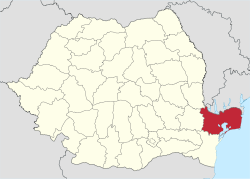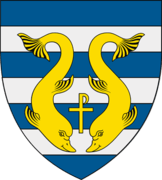Tulcea County
| Tulcea County Județul Tulcea | ||
|---|---|---|
| County | ||
| ||
 | ||
| Coordinates: 44°59′N 28°46′E / 44.98°N 28.77°ECoordinates: 44°59′N 28°46′E / 44.98°N 28.77°E | ||
| Country | Romania | |
| Development region | Sud-Est | |
| Historical region | Dobruja | |
| Capital | Tulcea | |
| Area | ||
| • Total | 8,499 km2 (3,281 sq mi) | |
| Area rank | 4th | |
| Population (2002) | ||
| • Total | 265,349 | |
| • Rank | 40th | |
| • Density | 31/km2 (81/sq mi) | |
| Telephone code | (+40) 240 or (+40) 340[1] | |
| ISO 3166 code | RO-TL | |
| Website |
County Council Prefecture | |

Tulcea (Romanian pronunciation: [ˈtult͡ʃe̯a]) is a county (județ) of Romania, in the historical region Dobruja, with the capital city at Tulcea.
Demographics
In 2011, Tulcea County had a population of 201,462. The population density was 23.7/km², the lowest among the counties of Romania.
In the Danube Delta there is an important community of Russians and Lipovans. In the south of the county there are communities of Turks. The region once was a centre of Islam in Romania.
| Year | County population[3] |
|---|---|
| 1948 | 192,228 |
| 1956 | |
| 1966 | |
| 1977 | |
| 1992 | |
| 2002 | |
| 2011 |
| Ethnicity | 2002[4] |
|---|---|
| All | 256,492 |
| Romanian | 230,843 (90%) |
| Lipovan | 16,350 (6.4%) |
| Turkish | 3,334 (1.3%) |
| Roma/Gypsy | 2,272 (0.9%) |
| Greek | 1,680 (0.7%) |
| Ukrainian | 1,279 (0.5%) |
| Tatar | 179 (0.1%) |
| Others | 555 |
Geography
The county has a total area of 8,499 km².

The most significant feature of Tulcea County is the Danube Delta, which occupies about 1/3 of the entire surface and is located in the North-East side of the county. The Delta has three main branches: the Sulina branch (the only one navigable by large ships) in the middle, the Chilia branch in the North (the border with Ukraine) and the Sfântu Gheorghe branch (Saint George) in the South.
In the South-East of the county there are two lagoons: Razelm Lake and Sinoe Lake. In the Danube Delta and in the South—in the area between the Sfântu Gheorghe Channel and Razelm Lake—there are countless channels and small lakes. The entire area is included in the UNESCO list of World Heritage Sites and Biosphere reserves.
The Danube River flows around the county in the West and North side. In the West there is the Măcin Branch which flows on the East side of the Great Brăila Island. From Smârdan (on the opposite side from Brăila) to Pătlăgeanca (close to Tulcea), the Danube has only one big flow of water, around which there are an immense number of lakes and small channels.
In the center of the county there is the Casincea Plateau and the Măcin Mountains—the remains of a prehistorical mountains range (more than 400 million years old), with the greatest height at about 400 m.
Neighbours
- Black Sea in the East.
- Brăila County in the West.
- Galați County in the North-West
- Ukraine in the North - the Odessa Oblast.
- Constanța County in the South.
Economy
Agriculture and fishing are the main occupations, involving about 48% of the population. Industry is concentrated in the large towns only.
The predominant industries in the county are:
- Food industry.
- Textile industry.
- Ship building industry.
- Metallurgy - aluminium.
- Chemical industry.
- Construction materials.
Tourism
Tourism is an important activity in the county, the Danube Delta being one of the most visited areas in Romania.
The main destinations for tourists are:
- The Danube Delta
- The town of Sulina—the last town on the Danube.
- The areas around Sfântu Gheorghe, Mahmudia, Crișan, Caraorman, Chilia Veche.
- The city of Tulcea.
- The Roman fort of Halmyris.
Politics
The Tulcea County Council, elected at the 2016 local government elections, is made up of 31 counselors, with the following party composition:[5]
| Party | Seats | Current County Council | ||||||||||||||
|---|---|---|---|---|---|---|---|---|---|---|---|---|---|---|---|---|
| Social Democratic Party | 14 | |||||||||||||||
| National Liberal Party | 12 | |||||||||||||||
| Alliance of Liberals and Democrats | 3 | |||||||||||||||
| People's Movement Party | 2 | |||||||||||||||
Administrative divisions

Tulcea County has 1 municipality, 4 towns and 46 communes
- Municipalities
- Tulcea - capital city; population: 92,379 (as of 2007)
References
| Wikimedia Commons has media related to Tulcea County. |
- ↑ The number used depends on the numbering system employed by the phone companies on the market.
- ↑ National Institute of Statistics, "Populația după etnie"
- ↑ National Institute of Statistics, "Populația la recensămintele din anii 1948, 1956, 1966, 1977, 1992 și 2002"
- ↑ National Institute of Statistics, 2002 census: Ethnic structure per county
- ↑ "Mandate de CJ pe judete si competitori" (in Romanian). Biroul Electoral Central. 10 June 2016. Retrieved 16 June 2016.

